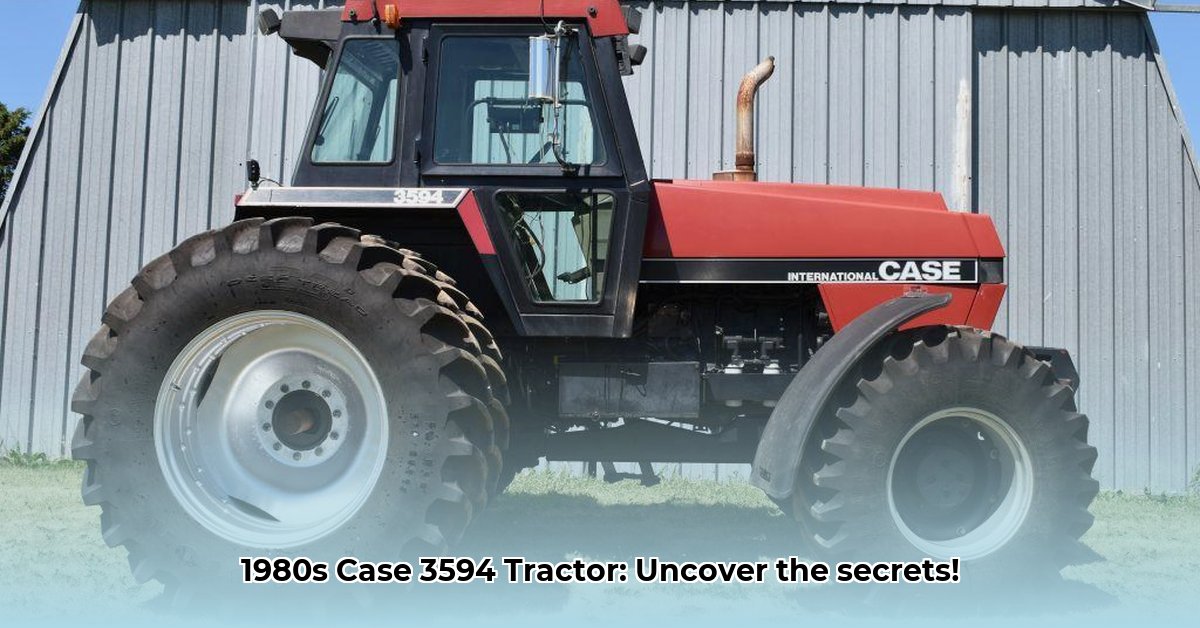
The Case 3594 tractor, a prominent machine of the 1980s farming landscape, stands as a testament to the era's agricultural advancements. This article explores its history, specifications, and enduring legacy, offering insights into its design and place within the broader context of vintage farm machinery. Understanding its capabilities sheds light on the evolution of agricultural technology and the demands of large-scale farming during that period. For more detailed specifications, see this Case 3594 resource.
3594 Case Tractor: Power and Performance
The Case 3594 boasted a substantial power output, delivering an estimated 180 to 202 horsepower depending on the specific configuration. This considerable power, crucial for handling heavy implements like planters and disc harrows across expansive fields, made it a highly sought-after tractor. How did this power translate to real-world efficiency for 1980s farmers? The tractor's capability likely contributed to increased yields and reduced operational time compared to less powerful models. This power came with a significant price tag, estimated at around $75,000 in 1987, reflecting its advanced engineering and the high demand for efficient machinery in large-scale farming.
Transmission and Hydraulics: Precision Engineering
Power transfer to the ground was facilitated by a sophisticated transmission system. The 3594 featured either a 12-speed or a 24-speed partial power shift transmission, offering smoother gear changes than many predecessors. This precision control allowed operators to optimize engine speed for various tasks, improving both fuel economy and productivity. The tractor’s hydraulic system, with a capacity of 33.25 gallons, could lift an impressive 7750 pounds to a height of 24 inches. While closed-center hydraulic systems were standard then, today’s open-center systems often provide superior efficiency.
Technological Advantages: A Comparative Analysis
Several factors set the 3594 apart from its contemporaries. Its favorable power-to-weight ratio minimized soil compaction, a significant concern for farmers. The synergistic combination of its robust transmission and powerful hydraulic system created a highly efficient farming package. While direct comparisons to similar John Deere or Ford models of the era are hindered by limited data, available evidence suggests the 3594 was a competitive contender, offering a compelling blend of power and maneuverability.
The Case 3594 Today: Legacy and Challenges
Despite its impressive capabilities, maintaining a Case 3594 today presents challenges. Parts are becoming increasingly scarce, and finding mechanics experienced with such vintage equipment can be difficult. This often translates into higher repair costs and potential downtime. However, the tractor has garnered a dedicated following among collectors and restoration enthusiasts, actively preserving these machines, and even creating a potential niche market for those appreciating its agricultural heritage. This ensures that a piece of farming history remains alive.
Specifications at a Glance
| Feature | Specification |
|---|---|
| Engine Horsepower | Estimated 180-202 hp |
| Transmission | 12 or 24-speed partial power shift |
| PTO Power | Approximately 182 hp |
| Drawbar Power | Approximately 160 hp |
| Hydraulic Capacity | 33.25 gallons |
| Lift Capacity | 7750 lbs at 24 inches |
| Approximate Cost (1987) | $75,000 |
The Enduring Legacy of the Case 3594
The Case 3594 serves as a significant marker in the history of agricultural machinery. While limitations in data availability hinder a fully comprehensive analysis, the tractor's impact on farming efficiency and productivity remains undeniable. Further research is needed to more precisely quantify its role and comparative performance.
Restoring a Vintage Case IH 3594 Tractor: A Labor of Love
Restoring a vintage Case IH 3594 is a demanding but potentially rewarding undertaking. This endeavor requires extensive knowledge, significant investment, and considerable patience. The primary hurdle is parts sourcing. Many components are no longer in production; finding suitable replacements demands time and financial resources. One enthusiast reported spending over $10,000 on parts for a substantial repair, highlighting the potential cost implications. 1
Key Considerations for Restoration
- Parts Availability: The scarcity of original parts represents a significant challenge and driver of costs.
- Specialized Skills: Restoration requires mechanical expertise and potentially access to specialized tools and services.
- Financial Resources: Budgeting for parts, tools, and potential unforeseen expenses is critical.
- Time Commitment: The restoration process is time-intensive, potentially spanning several months or even years.
A Step-by-Step Restoration Overview (Simplified)
- Assessment: A comprehensive inspection identifies the extent of damage and necessary repairs.
- Parts Acquisition: Securing replacement parts is a crucial and often lengthy process.
- Disassembly: Careful dismantling allows for thorough cleaning and repair of individual components.
- Repair/Replacement: Repair or replace damaged parts. This might involve welding, machining, or other specialized skills.
- Reassembly: Meticulous reassembly, guided by detailed documentation, ensures functionality.
- Testing & Refinement: Rigorous testing unveils any remaining issues and allows for fine-tuning.
Preventative Maintenance: Long-Term Investment
Implementing regular preventative maintenance dramatically reduces the likelihood of major repairs. This includes regular oil changes, fluid level checks, inspection of belts and hoses, and prompt attention to any unusual sounds or leaks.
Red Power Magazine Forum. (Various posts discussing Case 3594 repair costs). https://www.redpowermagazine.com/forums/topic/98595-case-3594/ ↩